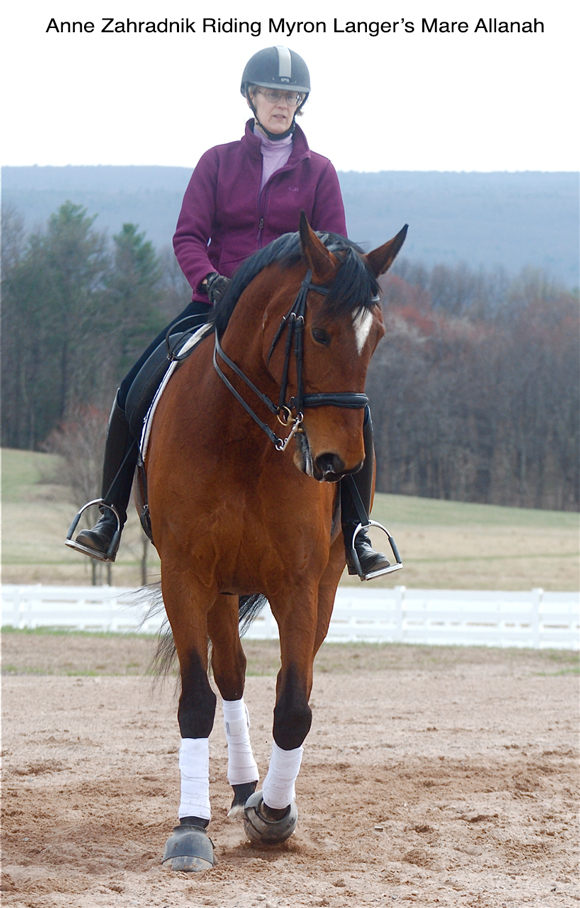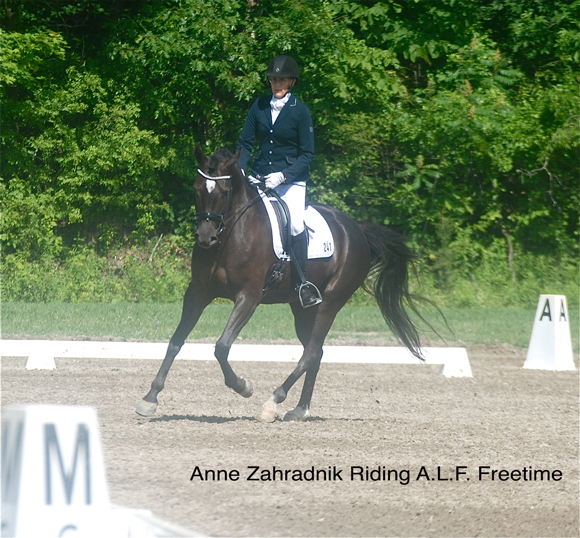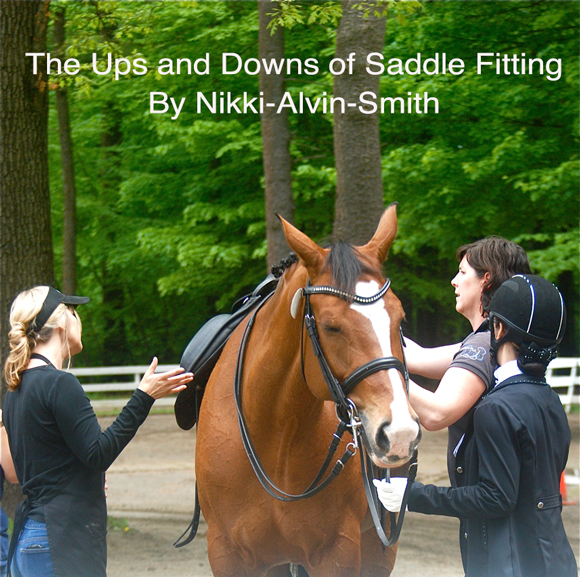The Ups and Downs of Saddle Fitting
by Nikki Alvin-Smith
You can’t have a horse with no saddle so, inevitably, most horse owners arrive at the door of the tack shop in search of a saddle for their wondrous beast.
Some riders shop on Ebay and on the internet, others hit vendors at horse shows, while some borrow a saddle from the barn or a friend. There are many pitfalls involved for both the buyer and the horse. Catskill Horse decided to ask an up-and-coming Adult Amateur rider in the dressage world, Anne Zahradnik, and a respected saddle fitter from Maine, Sara Kilguss, to sound in and offer some quick advice on the topic.

Here are a few Q & A sessions that might help you through the ups and downs of saddle shopping.
Here is what Anne Zahradnik had to say:
CH: What is the biggest misconception about saddle fitting?
AZ: That it doesn't need to be done. There are still people who think it's a waste of time and money and "we never did this back in the (fill in the decade here) so it's a stupid waste of money.”. My attitude is that a poorly fitting saddle that causes your horse pain can undo all of the other time and effort you invest in his training and welfare. Skipping it is penny wise and pound foolish.
CH: How many times does a saddle fitter need to come out, in your opinion?
AZ: It varies, depending on your horse's age and stage of training. A young horse or a horse in a sport that develops top-line muscles, such as dressage, jumping or competitive trail, will need to be checked at least twice a year. My current young horse has had his saddle checked and adjusted three times already this year. His top-line is changing that fast. If you are managing an athlete, you need to stay on top of the changes in his body shape and stay ahead of the saddle fit issues. You don't want to wait until the saddle is pinching badly enough to cause behavior or performance issues, then schedule the fitter, then wait 4-6 weeks until the fitter can come out.... A pleasure horse in consistent, non-developmental work will probably be fine with a once a year fit check and flock fluffing.
CH: What experiences, both positive and negative,have you generally had with trying to get a horse a properly fitted saddle?
AZ: The negative experience is the expense. A good fitter is not cheap. But, a bad fitter is a total waste of money and may even be detrimental to your horse's back health. A related negative is the frustration of getting an appointment with a good fitter. They are in high demand and are difficult to book. I book my fitter out months in advance, assuming I'll need her by that time, rather than wait until I need her, then have to wait a couple more months until she can fit me in. The positive experience is the satisfaction of knowing I'm doing everything I can to support my horse in his athletic development, and how well my horse goes in a good fitting saddle. If I expect him to be a professional athlete I have an obligation to support him as professional athlete.
CH: What sort of budget should someone allow for a fitter, i.e. what is reasonable in your opinion?
AZ: I pay from $125 to $250 for a fitting from one of the best in the business. Part of the cost is travel time and distance for the fitter. It always helps to keep costs down if you can get a group together and divide the farm call. Significant repairs, of course, add to the cost.
CH: Should a saddle manufacturer come out to show saddles?
AZ: Even if they are not trained as a saddle fitter? I've attended in-barn saddle demonstrations by a few different manufacturers over the years. They are informative and worth the time. But, you have to remember that person is making a sales pitch, so listen to their information with that in mind. A saddle fitter who does not rep a certain line will give you less biased information, but that doesn't mean you can't get good information from a manufacturer's rep. Plus, you can get the chance to ride in a bunch of saddles, which is also educational.
CH: What should people expect, return policy wise, if they purchase a custom saddle? What experiences have you had?
AZ: The one custom saddle I bought was a great fit and worked out well. I have had friends who had custom builds turn into expensive nightmares though. Be very clear up front about the terms and conditions of the contract and the possibility of returns. There is no Lemon Law for saddles. If you are spending $6,000 for a custom saddle, be sure you know what your recourse is if it doesn't turn out as expected. There is one famous manufacturer who has a reputation for absolutely awful custom experiences. Don't believe everything you read on the Internet, but do your research and ask around before committing. Be an informed consumer.
CH: What do you think of the general level of saddle fitting expertise that you have experienced? Do you believe a five day course is enough?
AZ: The professionals I use to support my horse all have an attitude of lifelong learning. A five-day course is a good start, but any professional should constantly be in learner mode, taking additional training as it comes available, and be open to new techniques and additional training. An old-fashioned apprenticeship is also an effective way to gain experience and expertise.
CH: Any advice/tips for both a neophyte buyer and an experienced buyer?
AZ: I see people talk themselves into saddles that fit the horse, but don't really fit them because "It's such a great bargain." People who are new to dressage and just learning the dressage seat seem to be most prone to this bad choice. If you are fighting the saddle to get and keep a good position, then the saddle won't work for you. There are thousands of options, so move on to try something else rather than forcing a fit, even if it seems like a good deal. No saddle is a bargain if it doesn't fit you as well as the horse. In related advice, beginners often get cheap synthetic saddles that don't do them or their horse any favors. They think starting out cheap is a good plan. I tell people [to] spend the same amount of money on an old, quality saddle rather than a new, cheap saddle. Many of the synthetic saddles put people in a chair seat. You'll never learn to use your aids effectively while sitting in the wrong position. Buy an older higher-quality saddle that helps you learn rather than hinders you. It really does make a difference to the rider as well as the horse. For experienced buyers, I'd say saddle manufacturers are constantly working on improving their wares, so stay open to considering all brands. If Brand Y didn't work out for you in 1995, don't write them off forever, because they are constantly making changes and improvements.
CH: What about referral programs/incentives for training barns?
Should students be made aware of these policies and should the discounts be passed along?
AZ: Referrals and trainer discounts are a common marketing tactic. I don't have a problem with them since trainers have bills to pay too. Whether the trainer decides to pass along the discount is up to her. She could cause barn drama, however, if she passes the discount to some people but not others. To be fair, she has to be consistent. The trainer should be open and above board about any such deals. I would not be put out if a trainer kept a referral fee rather than passing it along. I would be seriously put out if a trainer got a referral fee without letting me know, since her opinion on the saddle was being influenced by receiving that fee.
Here is some advice from Sara Kilguss, an experienced saddle fitter who is a representative for Custom Saddlery & Bliss of London, based in Maine, on the same topic.
CH: What is the biggest misconception that a saddle buyer has about saddle fit and the process when you visit them?
SK: Rather than common misconceptions, one of the most common issues I come up against is that people tend to have preconceived notions about what they like and do not like in saddles generally. What I find myself explaining and demonstrating constantly is that the fit and balance of any saddle is crucial to being able to sit comfortably in balance in that saddle. When looking for a new saddle, I encourage everyone to keep an open mind and [to] try as many different saddles as you can.
CH: What sort of return policies should a buyer who orders a custom made saddle expect in the industry,if they receive it and it does not work for them?
SK: I can only speak for the brands I represent which are Bliss of London and Custom Saddlery. I represent Custom Saddlery in VT, NH, and Maine. Custom works on a different system. Basically you pay Custom Saddlery a small deposit to order a saddle. You are not obligated to buy the saddle you order. When the saddle comes in, you have a ten day trial period to try the saddle and decide if you want to buy it. If you do, great! If you don’t, you return it, and we can put your deposit towards the purchase of another saddle through the company as long as a sale is finalized within 12 months.
When I sell a Bliss saddle, I purchase the saddle wholesale and then sell it retail to the client. The return policy for Bliss is my own. If you hate it or it is not working, I will do my best to work with you to get you something that will work. This varies on a case-by-case basis.
I have not had a Bliss saddle returned to this date.
CH: What price range should a buyer expect for a fitter to come out, and how often would one saddle fit need to be worked on? i.e. should they expect you to come once to try saddles and another to come back and fit a custom made saddle?
SK: As far as a price range for saddle fitting, that really depends on many factors. This is similar to how other horse services like farriers vary in price from region to region.
Personally, I charge a farm call fee and for my mileage, and then add my services on top. This is a pretty standard practice.
Mileage is $.55/mile and is split between all the clients I see on any trip. Call fee is $50/person or $35 each if I am seeing more than one person at any given stop. Flock adjustments are generally $75-$125 but, again, this can vary depending on the size of a job.
I charge $100 for a new saddle trial appointment — this appointment can take up to 3 hours and is very involved.
If a saddle is ordered during this appointment, I would only charge my travel fees to come check the fit on that saddle when it comes in.
CH: What changes, age and training wise, in a horse should a buyer expect to have to have the saddle re-fitted?
SK: Saddle fit should generally be checked once or twice a year depending on how much work the horse is doing, how much the horse is developing, and changes in the horse’s musculature.
CH: What can buyers do to make your job easier when you visit? How long should they expect the visits to be? What should they expect to do/provide?
SK: Clients should have their horse inside and groomed at the time of the appointment. Any tack that will be evaluated should be out and easily accessible. The client should be ready to ride as it is very important to evaluate the horse and rider together in motion as well as evaluating saddle fit on the cross ties.
A client should be able to speak about any veterinary or maintenance issues the horse is having, as well as any training issues. These could all be pertinent to evaluating the saddle fit.
Lastly, If the client wants the opinion of their trainer to be taken into consideration, it is often helpful to have the trainer present at the appointment.
To contact Certified Saddle Fitter, Sara Kilguss, please call (401) 419-7304 or visit her website at: www.sksaddlefit.com
About Anne Zahradnik and her present competition horse A.L.F. Freetime:

Five-year-old ALF Freetime++ is an Arabian Warmblood cross who has been having quite a successful summer, adding to his show record with many ribbons and high scores in open and breed shows, and a breed show regional championship in training level dressage. He has also earned several awards this season, including the first two levels of the Arabian Horse Association's lifetime achievement awards, the Legion of Honor, and the Legion of Merit. As of the time of press time, he is first in the USEF Region 16 in training level and first level dressage year-end awards, first in the nation for a USDF All Breeds year-end award, and first in the nation for an Arabian Sport Horse Alliance year-end award for Half-Arabians in dressage. In September, he will be competing in training level dressage at the Arabian Sport Horse National Championships. Anne Zahradnik, his owner and rider, believes correct saddle fit is one of the most important building blocks supporting his success in the competitive dressage court.



